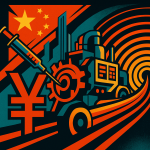Key Points
- Strong Revenue Growth: Eleven out of twelve STAR Market semiconductor equipment companies reported positive revenue growth in Q1 2025, with Beijing Jinyi Automation Equipment (京仪装备) leading at 54.23% YoY.
- R&D Surge & Strategic Investment: Many companies, like Piotech (拓荆科技) and Fuchuang Precision (富创精密), saw significant R&D spending increases and strategic capacity investments, sometimes leading to short-term net losses despite revenue growth.
- Varied Profitability: While revenue was strong, only 6 companies reported YoY net profit growth in Q1 2025, indicating profitability pressures due to high R&D costs and long validation cycles.
- Key Drivers: Growth is fueled by global AI demand, domestic substitution/localization efforts, strong policy support from initiatives like the “National Big Fund” Phase III, and major domestic fabs increasing procurement of Chinese equipment.
- Market Leaders: Companies like AMEC (中微公司) (up 35.4% YoY) and ACM Research Shanghai (盛美上海) (net profit up 207.21% YoY) are driving significant growth and profitability, making inroads against international competitors.

The semiconductor equipment sector listed on China’s STAR Market (Sci-Tech Innovation Board) is buzzing, largely driven by insatiable AI demand, and recent Q1 2025 earnings reports paint a fascinating picture.
It’s a story of impressive growth for many, but also strategic investment and profitability pressures for others.
Let’s dive into the numbers and trends shaping this critical industry.

Find Top Talent on China's Leading Networks
- Post Across China's Job Sites from $299 / role
- Qualified Applicant Bundles
- One Central Candidate Hub
Your First Job Post Use Checkout Code 'Fresh20'

Most Players See Strong Q1 Revenue Growth
Crunching the numbers from Cailian Press Star Mine Data (财联社星矿数据), we see 12 semiconductor equipment companies listed on the STAR Market, covering key areas like etching, thin-film deposition, testing, and cleaning equipment.
The big news? Eleven out of these twelve companies reported positive revenue growth in Q1 2025. That’s a strong signal.
Here’s the growth leaderboard for Q1 2025:
- Beijing Jinyi Automation Equipment (Jingyi Zhuangbei 京仪装备)
- Piotech (Tuojing Keji 拓荆科技)
- AccoTEST (Huafeng Cekong 华峰测控)
- ACM Research Shanghai (Shengmei Shanghai 盛美上海)
- Heron Intelligent Equipment (Xianfeng Jingke 先锋精科)
- AMEC (Zhongwei Gongsi 中微公司)
- Hwatsing (Huahai Qingke 华海清科)
- Naiketech (Naike Zhuangbei 耐科装备)
- Skyverse Technology (Zhongke Feice 中科飞测)
- Kingsemi (Xinyuan Wei 芯源微)
- Fuchuang Precision (Fuchuang Jingmi 富创精密)
Only Jingsheng Electromechanical (Jingsheng Gufen 晶升股份) saw a dip in revenue during the quarter.
STAR Market Semiconductor Equipment: Q1 2025 Performance Snapshot (Selected Companies)
Year-over-Year (YoY) Growth Based on Reported Figures

ExpatInvest China
Grow Your RMB in China:

(Image depicting Q1 2025 revenue growth rates)
Leading the pack is Beijing Jinyi Automation Equipment (Jingyi Zhuangbei 京仪装备), clocking a massive 54.23% year-on-year revenue increase to ¥338 million RMB ($46.9 million USD) in Q1 2025.
The company attributes this success to strong semiconductor equipment market demand and the competitive edge of its products.
Interestingly, alongside this growth, Jingyi Zhuangbei significantly ramped up its R&D spending in 2024, hitting ¥94.15 million RMB ($13.1 million USD) – a 53.06% increase YoY, representing 9.17% of its operating revenue.
This highlights a key theme: heavy investment in innovation is crucial, even during growth phases.
Another heavyweight, AMEC (Zhongwei Gongsi 中微公司), a domestic leader valued over ¥100 billion RMB, reported Q1 2025 revenue of ¥2.173 billion RMB ($301.8 million USD), up 35.4% YoY.
Its net profit also climbed 25.7% YoY to ¥313 million RMB ($43.5 million USD).
AMEC is making serious inroads, particularly in etching equipment for advanced chips (sub-5nm). Their 2024 revenue (¥9.065 billion RMB / $1.26 billion USD) reached nearly 15% of the scale of similar lines from giant Applied Materials, signaling a significant acceleration in domestic substitution or localization.

Resume Captain
Your AI Career Toolkit:
- AI Resume Optimization
- Custom Cover Letters
- LinkedIn Profile Boost
- Interview Question Prep
- Salary Negotiation Agent

Sub-Sector Performance: A Mixed Bag
Digging deeper, performance varies across different equipment types.
In thin-film deposition, Piotech (Tuojing Keji 拓荆科技) posted impressive revenue growth of 50.22% YoY (reaching ¥709 million RMB / $98.5 million USD), second only to Jingyi Zhuangbei.
This reflects continued high demand in the thin-film equipment market.
However, Piotech reported a net loss of ¥147 million RMB ($20.4 million USD) for the quarter.
Why the loss despite booming revenue? The company points to increased R&D investment, specifically for advanced process equipment below 12nm.
Chen Xinyi (陈新益), GM of Piotech’s ALD Business Unit, noted they have the largest installed base of ALD (Atomic Layer Deposition) equipment in China.
Crucially, nearly 70% of their Q1 equipment sales revenue came from new products and processes – underlining the payback potential of that R&D spend.
Over in measurement and inspection, Skyverse Technology (Zhongke Feice 中科飞测) saw Q1 revenue climb 24.9% YoY to ¥294 million RMB ($40.8 million USD).
Yet, it also faced an increased net loss of ¥15 million RMB ($2.1 million USD).
The reason? Extended validation cycles for their equipment at memory wafer fabs.
This “revenue growth without profit growth” dynamic isn’t uncommon.
An industry insider suggests it reflects the high upfront investment needed for high-end equipment R&D. The bet is that once customer certification comes through, performance will hit an inflection point.
Contrast this with Jingsheng Electromechanical (Jingsheng Gufen 晶升股份), whose Q1 revenue dropped 12.69% YoY to ¥70.81 million RMB ($9.8 million USD), and net profit slid 117.10% YoY to a loss of ¥2.53 million RMB (-$0.35 million USD).
Huatai Securities (Huatai Zhengquan 华泰证券) analysts link this to price cuts in the downstream EV market and inventory adjustments in the photovoltaic sector, combined with depreciation from new production lines and R&D hikes.
Looking back at the full year 2024 revenue growth, the top performers were:
- Heron Intelligent Equipment (Xianfeng Jingke 先锋精科) (over 100% YoY growth!)
- Skyverse Technology (Zhongke Feice 中科飞测) (>50% YoY growth)
- Piotech (Tuojing Keji 拓荆科技) (>50% YoY growth)
- Fuchuang Precision (Fuchuang Jingmi 富创精密)
- AMEC (Zhongwei Gongsi 中微公司)
The consistency from 2024 into Q1 2025 for most suggests improving market demand and solid growth potential.

The Profitability Puzzle & The R&D Surge
While revenue largely trended upwards in Q1 2025, net profit performance was much more varied.
This marks a shift from 2024, where 9 out of 12 companies saw positive YoY net profit growth.
In Q1 2025:
- 6 companies reported YoY net profit growth.
- 4 companies reported net losses.
Leading the profit charge was ACM Research Shanghai (Shengmei Shanghai 盛美上海), with a stunning 207.21% YoY surge in Q1 net profit to ¥246 million RMB ($34.2 million USD).
ACM Research credits the ongoing global semiconductor recovery, especially strong demand in mainland China, and a healthy order backlog.
Chairman David Wang (Wang Hui 王晖) recently stated their wet processing equipment market share in China’s logic chip market has surpassed 25%.
AMEC (Zhongwei Gongsi 中微公司) also delivered strong profit growth, up 25.67% YoY to ¥313 million RMB ($43.5 million USD), driven by increased shipments of high-end etching equipment for advanced logic and memory processes.
They’re also successfully introducing new thin-film deposition and EPI equipment.
Collectively, the big players like AMEC, ACM Research Shanghai, and Hwatsing (Huahai Qingke 华海清科) are driving the bulk of the industry’s profit.
However, others like Skyverse Technology (Zhongke Feice 中科飞测) and Fuchuang Precision (Fuchuang Jingmi 富创精密) slipped into losses, often due to *strategic capacity pre-investment* and *significant R&D spending*.
Fuchuang Precision, despite a Q1 loss of ¥22.16 million RMB ($3.1 million USD), spent ¥54.7 million RMB ($7.6 million USD) on R&D in the same period, up 16.26% YoY.
They explicitly cite capacity pre-investment, talent hoarding, and R&D investment as factors behind the loss – essentially, building for future growth.
Even Jingsheng Electromechanical, with modest 2024 revenue growth (4.78%) and declining profit (-28.7%), boosted its R&D investment by 16.39% YoY in 2024, reaching ¥44.25 million RMB ($6.1 million USD) or 10.41% of annual revenue.
Emphasis on R&D Investment (Selected STAR Market Companies)
Reported Spending Increases and Strategic Focus
As Wang Zhe (王喆), an analyst at CITIC Securities (Zhongxin Zhengquan 中信证券), notes, “the R&D cycle for semiconductor equipment is long, typically 3 to 5 years, and requires continuous investment to maintain technological leadership…” This demands sharp cash flow management.

Tailwinds: AI Demand, Policy Support, and Global Shifts
The broader market context looks promising.
According to industry association SEMI, global semiconductor equipment sales hit a record $117.1 billion USD in 2024, up 10.16% from 2023.
SEMI forecasts the market to reach $121 billion USD in 2025, with mainland China leading the expansion.
SEMI President and CEO Ajit Manocha highlighted China as the largest downstream market, potentially hitting $45 billion USD in equipment market size in 2024, with over $100 billion USD in planned investments over the next three years.
Key growth drivers include:
- Advanced packaging technology
- Applications like AI, 5G, and the Internet of Things (IoT)
Sun Qiang (孙镪), Chairman of AccoTEST (Huafeng Cekong 华峰测控), is bullish, stating, “This year, the domestic semiconductor packaging and testing equipment field shows good growth potential… New growth drivers… continue to drive demand for testing equipment.” He added that AccoTEST has a relatively full order book and expects continued revenue growth in 2025.
Huatai Securities sees market sentiment accelerating upwards, driven globally by regional fab build-outs and soaring demand for AI chips.
Crucially, policy support within China is a major catalyst.
The third phase of the National Integrated Circuit Industry Investment Fund (the “Big Fund”), launched in 2024, is directing 30% of its funds to support equipment and components R&D.
Companies like AMEC and Piotech have already received initial project funding.
This support seems to be translating into orders. Piotech mentioned having over ¥8 billion RMB ($1.11 billion USD) in orders on hand as of January, enough to cover production for two years.
Soochow Securities (Dongwu Zhengquan 东吴证券) noted that major domestic fabs like Yangtze Memory Technologies Corp (YMTC) (Changjiang Cunchu 长江存储) and ChangXin Memory Technologies (CXMT) (Changxin Cunchu 长鑫存储) have increased their procurement ratio of domestic equipment from 45% to 60%.
This directly benefited companies like ACM Research Shanghai, whose orders for batch cleaning equipment reportedly tripled YoY.
Hua Chuang Securities (华创证券) believes the National Big Fund III will ramp up support for core technologies.
The combination of cyclical recovery, domestic substitution efforts, and strong policy support is creating an accelerated growth window for China’s semiconductor equipment industry chain.
The intense R&D spending seen across the board, even amid profit pressures, underscores the strategic race for technological self-sufficiency and global competitiveness in the era of AI.

FAQs
What is the STAR Market?
The STAR Market (Sci-Tech Innovation Board) is a Nasdaq-style stock market board of the Shanghai Stock Exchange, launched in 2019. It focuses on attracting high-tech and strategically important emerging industries, including semiconductor companies, aiming to foster innovation and provide funding for growth.
Why is semiconductor equipment important for AI?
AI relies heavily on advanced semiconductor chips (like GPUs and specialized AI accelerators) for training complex models and running inference tasks. Manufacturing these powerful chips requires highly sophisticated semiconductor equipment for processes like etching, deposition, lithography, and testing. As AI demand booms, so does the need for the equipment to produce the underlying hardware.
What’s driving the growth in China’s semiconductor equipment market?
Several factors are driving growth:
1. Surging Demand: Driven by AI, 5G, IoT, EVs, and data centers requiring more advanced chips.
2. Domestic Substitution (Localization): A national strategic priority for China to reduce reliance on foreign technology and build a self-sufficient semiconductor supply chain, leading to increased procurement from domestic suppliers.
3. Policy Support: Significant government investment and initiatives like the “National Big Fund” provide funding and incentives for domestic equipment R&D and adoption.
4. Capacity Expansion: Chinese chipmakers (fabs) are aggressively expanding their manufacturing capacity.
Why are some companies seeing revenue growth but also losses?
This often happens in the semiconductor equipment sector due to:
1. High R&D Investment: Developing cutting-edge equipment requires massive, continuous R&D spending over long cycles (3-5 years), impacting short-term profitability.
2. Long Sales Cycles & Validation: Getting equipment qualified and accepted by fabs (customer validation) can take time, delaying revenue recognition or requiring upfront investment before large orders materialize.
3. Strategic Investments: Companies might invest heavily in new production capacity or talent acquisition ahead of anticipated demand, leading to temporary losses before these investments pay off.
4. Competitive Pricing: Intense competition can sometimes pressure margins, especially when trying to gain market share.
What is the “National Big Fund” and why does it matter?
The National Integrated Circuit Industry Investment Fund (国家集成电路产业投资基金), often called the “Big Fund” (大基金), is a state-backed investment fund established by the Chinese government to boost its domestic semiconductor industry. It provides significant capital to Chinese chip designers, manufacturers (fabs), equipment makers, and material suppliers. Phase III, launched in 2024, places a strong emphasis (reportedly 30%) on equipment and components, providing crucial funding to accelerate R&D, enhance capabilities, and drive the adoption of domestic tools, directly supporting the localization strategy.
References
- STAR Market Daily (科创板日报) via Cailian Press (财联社)
- Global Semiconductor Equipment Sales Top $100 Billion for Third Consecutive Year, SEMI Reports – SEMI
- China’s chip equipment imports surge 14% in March as demand stacks up – Reuters
- Chinese chip tool maker AMEC expects strong first half as demand continues to grow amid US sanctions – South China Morning Post




![Pinduoduo's Playbook: How C2M and Social Shopping Built an E-commerce Giant [FreshFromChina]](https://freshfromchina.com/wp-content/uploads/2025/05/Pinduoduos_Playbook_How_C2M_and_Social_Shopping_Built_an_E-commerce_Giant_TeamedUpChina-150x150.png)